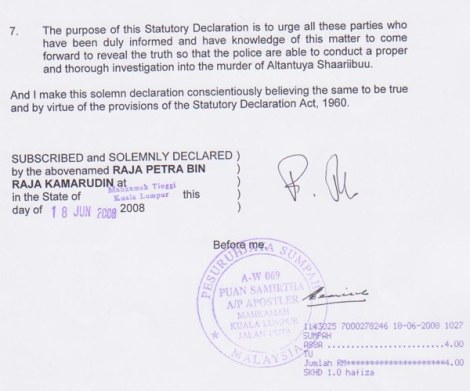
One of an important component in the ‘Malaysia Airlines-AirAsia share swap deal’which was inked on 9 August 2011 is Khazanah Nasional Bhd. now has a ‘first right refusal’ option to acquire AirAsia X’s 10% holdings. Of course, in his briefing to the press the price have yet to be determined, probably due to short time frame.
Wednesday August 17, 2011
AirAsia X-Khazanah deal hinges on valuation
PETALING JAYA: Investment bank Morgan Stanley is expected to finalise the proposed valuation of the 10% stake in AirAsia X to be purchased byKhazanah Nasional Bhd and present it to the long-haul budget carrier’s board by September, according to sources.
While it was too premature to put a price tag on the proposed purchase, sources said Morgan Stanley had been appointed the deal adviser and was currently working on the deal valuation.
Khazanah will be issued new shares in AirAsia X and is expected to come in as a pre-initial public offering (IPO) investor of AirAsia X, ahead of the airline’s plans to list next year.
In 2008, AirAsia X executed an agreement to place a 20% stake to Bahrain-based Manara Consortium and Japan’s Orix Corp for US$75mil (or RM250mil). When the placement was done, it was one year after the long-haul low-cost carrier established operations.
The valuation placed on AirAsia X’s shares today would be higher given the growth and expansion in business experienced by the airline since.
Last year, AirAsia X achieved a revenue of RM1.3bil with a net profit of RM80mil from carrying some 1.92 million passengers. The airline targets to touch RM2bil in revenue this year, owing to better ancillary income and higher yields, and carry some 2.7 million passengers.
AirAsia X now has a fleet of nine Airbus A330 and two Airbus A340 with a route network to 15 destinations globally.
“Everything hinges on the valuation before Khazanah will look to accept the share purchase. So it is not a done deal just yet,” said the source.
When contacted, AirAsia X chief-executive officer Azran Osman-Rani said Khazanah’s potential participation would signal the entry of a strong institutional investor into the company and would be used as a benchmark for the subsequent IPO price.
Current shareholders of AirAsia X include Aero Ventures Sdn Bhd (52%),AirAsia Bhd (16%), Corvina Holdings (10%), Orix Corp (11%) and Manara Consortium (11%)
Last week, Malaysia Airlines (MAS), AirAsia and AirAsia X signed a collaboration agreement, whereby the outcome of the agreement will see MAS focus on being a full-service premium carrier, AirAsia on being a regional low-cost carrier (LCC) and AirAsia X, a medium-to-long-haul LCC.
Azran said it was important for an airline to establish a clear product positioning and brand. The deal would allow all three airlines to operate in their respective market segments.
He added that a premium airline like Singapore Airlines realised the need to set up a separate entity, a long-haul budget carrier, to compete with AirAsia X so as not to dilute the parent company’s brand.
“Previously, when MAS was competing with AirAsia X, it didn’t make sense,” Azran said.
The agreement creates a clear distinction in which segments the three local airlines will operate in and Azran said it was an increasing global trend to see airline groups set up different carriers within an airline group to address different segments, as seen with Qantas’ announcement yesterday in establishing a new premium airline in Asia.
Azran also emphasised that the collaboration agreement gave promise to a more rational route policy that would allow all three airlines to compete globally and domestically.
“The agreement allows us to align capacity to where demand is. For instance, there are a large number of people flying Singapore Airlines to Kuala Lumpur from Sydney as there is not enough capacity,” he added.
Azran had previously stressed that a factor weighing on its IPO process was the lack of a route allocation policy by the Government, which was needed to provide clarity for the airline’s current and future investors.
*****************
AirAsia X is a private company, which belongs to AirAsia CEO Tan Sri Tony Fernandes, ED Dato’ Kamaruddin Mernanun and several others. Personalities behind AirAsia X are rather elusive. The former NSTP Deputy Chairman Kalimullah “Riong Kali” Hassan used to be the Chairman when AirAsia X was first incorporated.
Business reports in the early days of AirAsia X shown that the majority control of the intercontinental so-called low cost carrier is foreign owned, which include ACE 48% and Richard Branson via Virgin 20%.
Milton joins Branson in backing AirAsia X
Thursday, 27 March 2008
Robert Milton, head of ACE Aviation Holdings Inc revealed his “minor” interest in the Asian Pacific holdings company, Aero Ventures, that possesses 48% of low-cost carrier Air Asia X.
Upon announcing himself as a founding shareholder, Mr Milton said “My involvement with AirAsia X has provided me with the exciting opportunity to participate in the newest and most promising airline business model.”
AirAsia X is a low-cost, long haul affiliate of Malaysia’s regional carrier AirAsia. It attempts to expand Air Asia’s no-frills air service to international destinations, currently connecting Malaysia with Australia and China since its inaugural flight last November.
Low-cost carriers are yet to be a staple in the Asia Pacific, although they have an established industry in North America and Europe, according to Richard Aboulafia, Teal Group analyst.
He describes AirAsia X as a “pioneer” in the East, in its efforts to extend the model to international routes, as opposed to mere transcontinental travel such as Jetstar Asia Airways and Tiger Airways.
The question of demand has been answered by the International Air Transport Association, who recently forecasted the Asia Pacific market to develop as the largest individual market for air travel within 5 years.
Milton is not the only prominent shareholder in AirAsia X, as Sir Richard Branson’s Virgin Group owns 20% of the airline, according to the Financial Post.
Branson has publicly committed to ensuring the profitability of the new airline.
Forthcoming successes of AirAsia X could also provide an additional boost to Milton’s credibility, as his rescue plan for ACE, parent of Air Canada, has been lauded by industry officials since its emergence from bankruptcy protection in 2004.
ACE eventually returned billions of dollars in proceeds to its shareholders.
Undoubtedly sharing similar hopes for AirAsia X, Dato’ Tony Fernandes, Aero Ventures’ shareholder and founder of AirAsia X, said, “Robert brings to the table significant aviation expertise and will be able to contribute greatly.”
Milton has voiced his confidence in the low-cost carrier, as he said yesterday, “I believe AirAsia X has great potential as the first truly low-cost long-haul carrier in a region which will see significant future traffic growth.”
Milton noted that this was, also, “an area of the world to which I also happen to have strong personal ties.”
**********************
|
If these reports are accurate, it means that AirAsia X is foreign owned and Khazanah with its 10% holding means that it would ride on the strategic decisions made by the Europeans. Currently, the shareholders of AirAsia X a s a private company is rather hazy. Despite having a ‘share swap deal’ with Fernandes, Kamaruddin and Tune Air via AirAsia, it is unsure how the mechanics of the whole deal translate to the pareto optimal principle of the agreement. It is the fundamental legal basis of the ‘strategic alliance’ and probably ‘airline rationalisation plan’, Part II.
However, the ‘share swap deal’ is being discluded in how AirAsia X will operate from now on as Fernandes, Kamaruddin and Tune Air’s holding as minority shareholders, then probably Khazanah would be sucked into Fernandes’s game of raising cash from international capital market via IPO. Conveniently two days after Fernandes entered into agreement with Khazanah, he prematurely announced AirAsia X’s IPO.

Riong Kali is an integral and pivotal part of AirAsia and AirAsia X
It is an open secret how PM ‘Flip-Flop’ Dato’ Seri Abdullah Ahmad Badawi’s administration gave Fernandes so much ‘patronage’, room and opportunities to develop AirAsia into what it is. It was said that in the infamous ‘airline rationalisation plan’ which was presented to the Cabinet in mid 2005, Malaysia Airlines was suggested to give away 110 of its domestic and regional routes to AirAsia. Then again, the Cabinet also approved the directive that Malaysia Airlines have a ‘floor’ fare price, to allow AirAsia to quickly develop its market as a low cost carrier.
It was this time that AirAsia X was launched. It is believed that personalities who are still within AirAsia X remained the same. They key players and backers would remain constant.

Richard Branson and AirAsia X
One of the mitigating circumstance for Fernandes to push for the ‘share-swap deal’ is about the maintenance, repair and overhaul (MRO) for AirAsia and particularly AirAsia X. At the moment, the engineering C, D and E checks are being outsourced to Singapore. This would not make business sense if AirAsia were to expand. Particularly, AirAsia X’s wide-body fleet. On top the current 9 A330s and 2 A340s, there is an other of 16 A330s and 10 A350s from Airbus. The MRO bill for this fleet to be outsourced would be huge.
What does not makes sense to AirAsia X’s CEO Azran Osman-Rani’s statement is that the so-called ‘low cost intercontinental carrier’ is a ‘third’ airline within the soon to be ‘airline rationalisation exercise’, where the c0-owners between Malaysia Airlines, AirAsia and probably AirAsia X would sit down and carve their own markets.

AirAsia X's Premium Class 'Flat Bed' seats
AirAsia X introduced ‘Premium Class‘, which is in direct competition to Malaysia Airlines Golden Club Class. This is clear direct competition against the national carrier.
Now to the crux of the commercial bit already at hand. Part of the ‘share swap deal’ is the concept of pareto optimal, where according to Khazanah management “No parties would be made better off at the expense of someone else”. As it is, this Premium Class is in direct competition to Malaysia Airlines, in lucrative sectors such as London, Perth, Incheon and Sydney. So if AirAsia X were to expand and continue to offer this service, it would be at the expense of Malaysia Airlines. Would Khazanah now either ask AirAsia X to discontinue is expansion plan or refurbish all existing aircrafts and discontinue the service that would be in direct competition to Malaysia Airlines’ Golden Club Class?

Malaysia Airlines' Golden Club Class
Probably, the most likely AirAsia X’s argument to this tend to go for “Lets have a healthy comptetion and let the consumers choose and give them more options”. Thus, would the Federal Government care to ‘think outside the box’ and allow laissez faire to take its place in this ‘healthy’ capitalism-entrepreneurial practice and allow ‘liberalisation of the open sky’ policy?
We at BigDogDotCom is suggesting more airlines licenses to be issued. Especially for new markets and services, particularly point-to-point which current airlines are not serving. This is about dedicated destinations such as Langkawi-Phuket, Langkawi-Medan, Langkawi-Chennai, Langkawi-Koh Samui, Langkawi-Bangkok, Penang/Langkawi-Denpasar, Penang/Langkawi-Jakarta, Penang/Langkawi-Dubaii/Abu Dhabi, Penang/Langkawi-Perth, Penang-Mumbai, Penang-Tioman, Penang-Phuket, Penang-Koh Samui, Penang-Hadyaii, Kuching-Tioman, Kerteh-Singapore, Kerteh-Miri, Kerteh-Bintulu etc.
The permutation and opportunities are enormous.
These new niche’ market boutique airlines or even ‘air taxis’ would serve and promote the tourism, business and commercial and logistics markets and demands. Some of these boutique airlines would even do their own ‘collaboration’ and jointly serve certain sectors, especially during specific peak seasons. Special charters could also flourish, especially for C-to-C arrangements.
The demand for ‘fly-and-cruise’ could also be explored.
Let the market forces put this idea to the fullest test and the true spirit of ‘entrepreneurism’ and ‘the survival of the fittest’ being practiced. Then only the Malaysian civil airline and logistics sector could be matured. Of course, this could be the boon for peripheral and spin-off industries.






















Selamat Hari Merdeka (Four PUB facilities handed back)
Today marks the 54th celebrations of Independence and the proclamation of the newly formed sovereign state, Federation of Malaya. The Constitution of Federation of Malaya also came to force. YTM Tunku Abdul Rahman Putra who led the negotiations with Whitehall, wtinessed the lowering of the Union Jack from Malayan soil.
Gunong Pulai dam, built in 1924
Today also will be a historic moment as Singapore Public Utilities Board hands over Gunong Pulai water treatment plant and dam, Sg Skudai and Pontian water treatment plants and Sg Tebrau pumping station to the Government of Johor. The Gunong Pulai plant has been in operation since 1924 where else the Sg Tebrau pumping station was commissioned in 1953.
The 50 year water agreement signed in 1961 between the Government of Johor and Singapore City Council ended yesterday and these facilities will be handed over at no cost of acquisition. In fact, in the hand over agreement Singapore PUB agreed to ‘make good’ of the said facilities before handing it back.
HRH Sultan of Johor will witness the formal handing over in the morning. Besides Sultan Ibrahim, Menteri Besar Datuk Abdul Ghani Othman, state secretary Datuk Abdul Latif Yusof and all state executive councillors will be there along with Singapore’s Community Development, Youth and Sports Minister Dr Vivian Balakrishnan and Senior Minister of State for National Development and Education, Grace Fu, and PUB officials would also witness the historic moment in one of a landmark event in the bi-lateral relations between the two neighbours.
Two other PUB facilities are still operational to supply raw water for the consumption of Singaporeans, which is Sg Lingui and Sg Johor dams.
- Economic analysis and commentary
on August 31, 2011 at 00:05 Comments (2)